Coat of arms
|
John Murray, 1st Earl of Annandale (died 1640) was a Scottish courtier and Member of Parliament. [1]
He was known as John Murray of Lochmaben or Lincluden, and John Murray of the Bedchamber. John Murray was the 6th surviving son of Sir Charles Murray (d. 1605) of Cockpool, Dumfries and Margaret Somerville, a daughter of Hugh Somerville, 5th Lord Somerville. [2]
He served as a page to Anne of Denmark before becoming a Groom of the Bedchamber to James VI of Scotland. In 1600 he was given a pension from the estates of Dundrennan Abbey. [3] He moved to London with James in 1603 when he became James I of England at the Union of the Crowns. Murray became a conduit for Scottish royal business at court. A number of letters and petitions addressed to him survive in the National Library of Scotland.
Murray was rewarded with properties in England. On 22 May 1605 he was granted Plumpton Park in Hesket in the Forest of Inglewood, then regarded as part of Debatable Lands between Scotland and England. Thomas Musgrave of Bewcastle, the owner of Plumpton, resisted this grant. In October 1605 Murray was awarded a yearly pension of 200 marks, as a servant of the queen. [4]
In July 1609 the king gave him £100 to repair an old priory, Guildford Black Friary, near the royal park at Guildford. [5]
He was naturalised as a denizen of English in 1610. He became Keeper of the Privy Purse in 1611 in the place of Robert Jousie, a textile merchant and partner of the goldsmith Thomas Foulis.
Elizabeth Stuart, Queen of Bohemia wrote to him from Heidelberg in June 1613. Abraham Harderet brought the letter, which explained that she had been obliged to buy jewels from him to give as gifts at her wedding, many more than she could pay for, and he could show Murray the bills she had signed. She wanted to Murray to arrange it so the Chancellor of the Exchequer would pay Harderet. She would not trouble Murray or the king again, except only for her servants, and she sent a list of her household. Abraham Harderet was Anne of Denmark's jeweller, and had travelled with Elizabeth to Germany. [6]
New lodgings were built at Whitehall Palace for Murray and the Marquess of Buckingham from 1617. They were distinct buildings, though both near the privy gardens. [7]
In 1621 he became Member of Parliament for Guildford, [8] and bought Tyninghame House in East Lothian from the Lauder family for 200,000 merks. [9] In 1622 he was promoted to Gentleman of the Bedchamber. [10] The Marquess of Hamilton praised him in a letter to the Marquess of Buckingham, writing that he "is a very safe man, and I must say a zealous servant of yours". [11]
King James made him Lord Lochmaben and Viscount Annand in the peerage of Scotland then Charles I made him Earl of Annandale, also in the peerage of Scotland. In September 1623, Prince Charles came to his at Guildford on his return from the Spanish Match. [12]
Murray continued as Groom of the Bedchamber to Charles I. He was also Constable and Keeper of Falkland Palace and the Lomond Hills. [13] Andrew Murray of Balvaird advised him that the back galleries of the Palace were decayed in 1615. [14] In 1639 Balvaird helped him repair the keeper's house at Falkland, called the Castlestead or Nether Palace of Falkland. [15]
Many letters to Murray from Scottish correspondents survive, mostly on political and church business. He delivered letters from Francis Bacon to the king. [16] William Couper, Bishop of Galloway asked him to buy saddles for his wife and daughter, because they were much cheaper in London. [17] The lawyer Thomas Hamilton advised him about the ownership of a hoard of gold coins found by a tenant on his lands near Lincluden. [18]
He married Elizabeth Schaw, niece of William Schaw, and lady-in-waiting to Anne of Denmark, and had with her a son and a daughter. [19] His son James (d. 1658), later Earl of Annandale and Viscount Stormont, was baptised in the Chapel Royal at Holyrood Palace on 19 August 1617, William Couper preached and Anne Livingstone, Countess of Eglinton, presented the child. [20] [21]
He died in 1640. [2]
Many of Murray's papers were transferred to the collection of James Balfour of Denmiln and are now held by the National Library of Scotland. [22]
|

Robert Bruce Stuart, Duke of Kintyre and Lorne was the fifth child of James VI of Scotland and Anne of Denmark. He was born at Dunfermline Palace, Fife. On 2 May 1602 he was created Duke of Kintyre and Lorne, Marquess of Wigton, Earl of Carrick and Lord of Annandale. He died at Dunfermline Palace on 27 May 1602 and was buried at Holyrood Abbey.
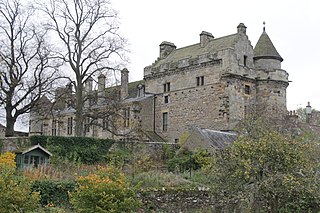
Falkland Palace, in Falkland, Fife, Scotland, is a royal palace of the Scottish Kings. It was one of the favourite places of Mary, Queen of Scots, who took refuge there from political and religious turmoil of her times.

John Erskine, 2nd Earl of Mar was a Scottish politician, the only son of another John Erskine and Annabella Murray. He is regarded as both the 19th earl and the 2nd earl.

Alexander Seton, 1st Earl of Dunfermline (1555–1622) was a Scottish lawyer, judge and politician. He served as Lord President of the Court of Session from 1598 to 1604, Lord Chancellor of Scotland from 1604 to 1622 and as a Lord High Commissioner to the Parliament of Scotland.
William Schaw was Master of Works to James VI of Scotland for building castles and palaces, and is claimed to have been an important figure in the development of Freemasonry in Scotland.
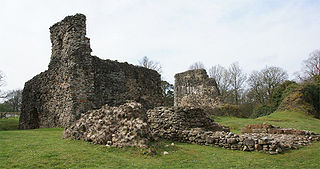
Lochmaben Castle is a ruined castle in the town of Lochmaben, the feudal Lordship of Annandale, and the united county of Dumfries and Galloway. It was built by Edward I in the 14th century replacing an earlier motte and bailey castle, and later rebuilt during the reign of James IV of Scotland. The earlier motte-and-bailey castle was built south of the current castle in c. 1160 by the Bruce family, Lords of Annandale.
Patrick Gray, 6th Lord Gray, known most of his life as Patrick, Master of Gray, was a Scottish nobleman and politician during the reigns of Mary, Queen of Scots and James VI of Scotland.
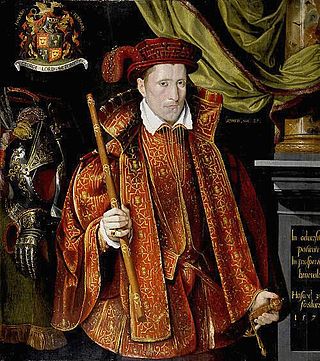
George Seton V, 7th Lord Seton (1531–1586), was a Lord of the Parliament of Scotland, Master of the Household of Mary, Queen of Scots, and Provost of Edinburgh. He was the eldest son of George Seton, 6th Lord Seton, and Elizabeth Hay, a daughter of John Hay, 3rd Lord Hay of Yester. His childhood and schooling were in France.

Sir Peter Young (1544–1628) was a Scottish diplomat, Master Almoner, and tutor to James VI of Scotland.
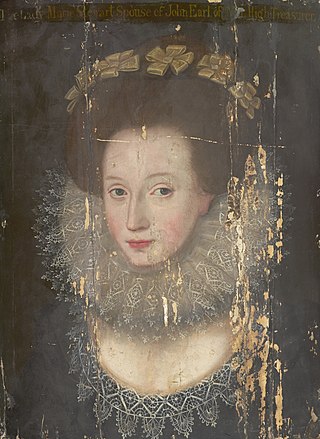
Marie Stewart, Countess of Mar (1576-1644) was a Scottish courtier. She was the daughter of Esmé Stewart, 1st Duke of Lennox and Catherine de Balsac d’Entragues (d. c.1631) and a favourite of James VI of Scotland. After her marriage, as was customary in Scotland, she did not change her name, and signed her letters as "Marie Stewart".
Anne Livingstone, Countess of Eglinton was a Scottish courtier and aristocrat, and lady-in-waiting to Princess Elizabeth and Anne of Denmark.
Elizabeth Schaw was a Scottish courtier and a lady-in-waiting to Anne of Denmark.
Abraham Harderet, goldsmith and jeweller to Elizabeth I of England and Anne of Denmark

Alexander Elphinstone, 4th Lord Elphinstone (1552-1638), was a Scottish courtier, landowner, and Lord Treasurer.
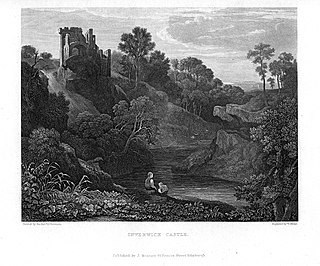
James Maxwell, 1st Earl of Dirletoun was a Scottish courtier and landowner, and Black Rod. He was involved in selling royal jewels.
John Auchmoutie of Scoughall was a Scottish courtier and performer in masques.

John Gibb of Knock and Carribber (c.1550–1628) was a Scottish landowner and courtier.
George More was an English supporter of Mary, Queen of Scots, and a participant in the Throckmorton Plot. A Catholic exiled in the Spanish Netherlands, he visited the royal court of Scotland in 1598.
Henry Wardlaw of Pitreavie (1565–1637) was a Scottish courtier and administrator.

Records survive of the expenses made to feed the Scottish royal household in the sixteenth century, and the remains of royal kitchens can be seen in the ruins of palaces and castles. Archaeologists can recover evidence of diet from deposits including waste from meals and food preparation.